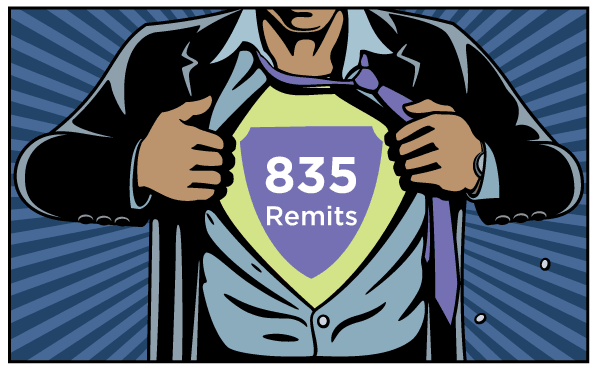837 Claims – 835 Remit Optimization


Want to know how healthcare IT organizations can best prove their worth to the business? Optimize the 835 Remit and 837 Claim process so there are fewer rejections, clarifications, missed files and delays.
There is a good reason why Revenue Cycle Management (RCM) is a strategic imperative for healthcare organizations. Short ARO (accounts receivable outstanding) times and revenue predictability are key metrics for any strong busienss. Healthcare RCM spans from appointment booking through 837 Claim – 835 Remit all the way to collections. And while staff training and optimization of human centered workflows are essential to effective RCM, automation through technology provides an opportunity for IT organizations to shine.
Managed File Transfer systems have proven their ability to optimize a central aspect of the revenue cycle, the 837 Claim – 835 Remit process, in a growing number of healthcare organizations.
In this post we’ll lay out a three step process to get there.
Focus on Revenue Drivers
Your organizations revenue cycle spans from the time a patient first makes an appointment to the point that full payment is made for the services extended. While payment sources include collection of co-pays and balances after insurance coverage, the lion’s share of revenue come from claims reimbursements.
You might think that shortening the collection of outstanding balances after insurance reimbursements should be mission critical. But consider the potential for wasted time and human error that lies in your 837 Claim – 835 Remit process.
If there are legacy systems, human based workflows or disparate file transfer systems and the majority of your revenues come from insurance reimbursements – you’ve identified the low hanging fruit. Improvements here will pay huge dividends to the business and make the IT organization a true business partner.
Identify Sources of Delay and Error
The typical healthcare provider deals with the complex and proprietary rules of a good number of payers on a given day. Claims can be denied just because they weren’t submitted properly. Industry sources indicate that, where a clean claim (no error) can cost $1 to process, refiling charges can run to over $25.
We’ll let you do the math re the number of claims your organization processes per week. But we can venture a guess that cutting the number of refiles by even 25% would save a heck of a lot of money. That money can flow back to new services, expanding the network, new equipment – you get the picture.
As an IT pro, you also know that any time a human is involved in the process, the potential for error increases. Remember PICNIC (problem in chair not in computer). If you have humans submitting an 837 Claim and manually handling an 835 Remit, there is a veritable gold mine of opportunity for technology to step in and eliminate a huge portion of the refiles.
Maybe you’ve already taken that step and have FTP servers and scripts doing a lot of the automation? Well guess what, IT pros are humans too. OK maybe superior humans, but humans none the less. So are your claims being processed through a disparate set of FTP servers on different platforms with scripts written by people who are no longer there? Rules change and it is likely that some of these workflows you are using are antiquated and can be generating a number of claims rejections. We won’t even go into the security or HIPAA compliance issues this may be causing.
Consider consolidation to a centralized system. A well-oiled billing function can remove human errors that lead to unnecessary claims adjudication (which can become an expensive proposition). The better optimized your 837 Claim – 835 Remit process the better your first-pass payment rate. Your billing cycle becomes shorter and everyone benefits.
Optimize through the Application of Technology
When it comes to optimizing business processes, the rule is to favor simplicity. Unfortunately, given the current healthcare payment system, the decks are stacked against you. And given that politicians have an undo say here, that is not likely to improve any time soon.
The good news is, however, that the complexities of medical insurance favor technology implementations. Because once a complex rule is correctly codified in say a script or automated workflow, the likelihood of error is significantly reduced.
Your best bet is too look into migrating to a Managed File Transfer system and specifically one that has strong Workflow Automation (not scripts).
Managed File Transfer – When it comes to the external transfer of healthcare data – which is what you are doing in the 837/835 and 270/271 processes – nothing beats a Managed File Transfer system. This is a core business process. Optimization here can save your organization money. Any IT pro knows that the more management visibility you have in the tools that facilitate these processes the better.
A Managed File Transfer system allows you to:
- Take EHR output from your core systems and transfer them as 837 Claims to a clearinghouse or payers.
- Assure delivery with automatic re-sends in case of outages or transmission failures.
- Automatically receive and forward 835 for payment posting
- Assure adherence to individual payer terms and conditions as well as incentive plans
- Ensure compliance with HIPAA data protection requirements
- Track and report on all file transfer activities
- Consolidate legacy FTP servers and scripts
Workflow Automation – The revenue cycle includes the 270 Inquiry, 271 Response, 837 Claim and 835 Remit. Like cogs in a gear, if one is off, the whole cycle can be thrown out of whack. Each insurer or payer organization has different submission rules, procedures and timelines. Some have incentives for timely submissions.
This isn’t an area that should be left to human processing. Sick days, lack of sleep, new hire training and inattention can have real costs. Once an individual payer’s processes are well understood and documented an automated, technology based workflow can assure it all flows like clockwork.
This is an area, however, where a number of healthcare providers have found legacy approaches based on FTP servers and scripts can be problematic. Complex workflows may require complex logic and not all script writers are created equal. It isn’t always easy to figure out the logic behind another person’s script either. Many healthcare organizations are finding that, although IT pros love to write scripts, this isn’t always the best use of their time.
A solution that simplifies workflow automation with drag-and-drop interfaces can save a lot of time reducing IT workloads and minimizing errors.
Conclusion
Your medical billing and payment systems have to operate in a world of increasing complexity. The potential for human error and unnecessary delays directly affects key business performance metrics like Accounts Receivable Outstanding. The extent to which you can optimize these systems can have a huge impact on your organizations ability to reduce costs and reinvest the savings into business and service improvements.
Managed File Transfer systems have proven effective at enabling the optimization of core business operations processes such as 837 Claim – 835 Remit. They ensure new levels of manageability, visibility and predictability that are key to today’s healthcare organizations strategic focus on Revenue Cycle Management.

Kevin Conklin

Latest Stories in Your Inbox
Subscribe to get all the news, info and tutorials you need to build better business apps and sites